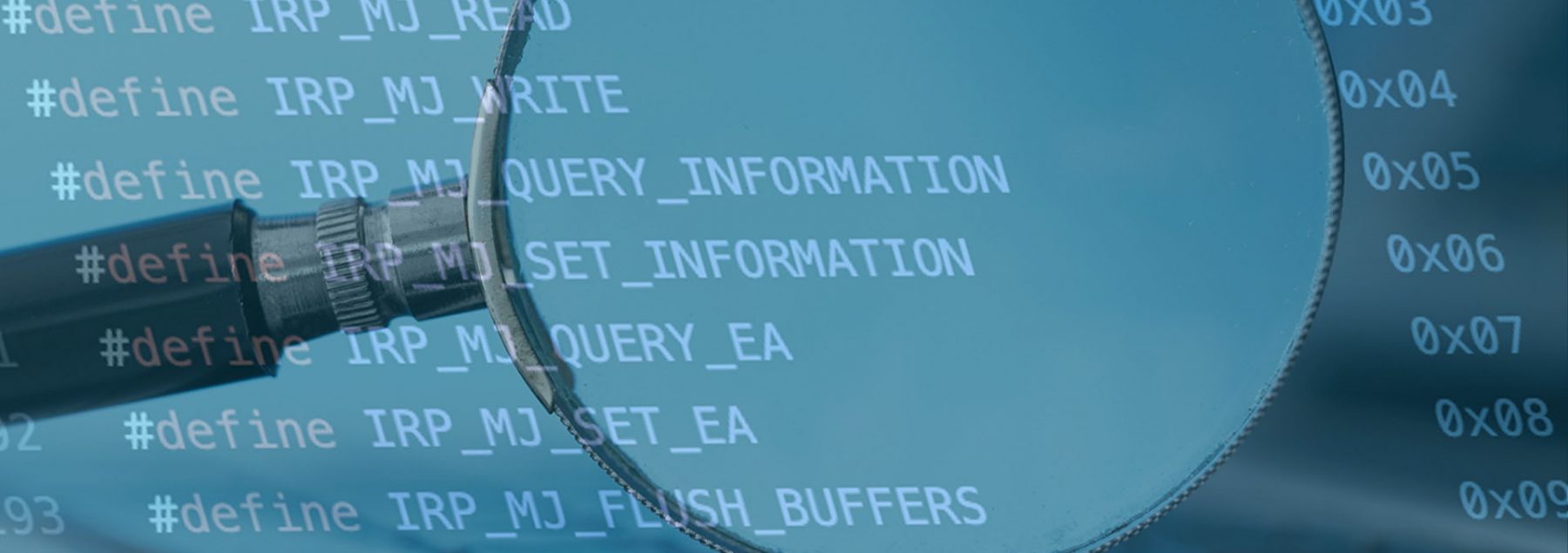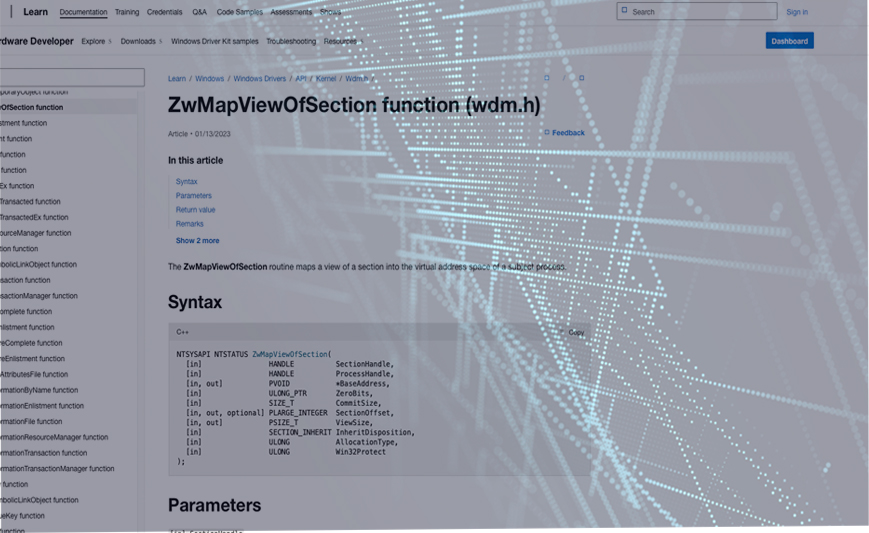I posted a poll on twitter (Christopher on Twitter: “Next blog topic?” / Twitter) to decide on what this blog post would be about, and the results indicated it should be about Kernel driver reversing.
I figured I’d make it a bit more exciting by finding a new Kernel 0-day to integrate into the blog post, and so I started thinking what driver would be a fun target.
I’ve reversed VMware drivers before, primarily ones relating to their Hypervisor, but I’ve also used their vCenter Converter tool before and wondered what attack surface that introduces when installed.
Turns out it installs a Kernel component (vstor2-x64.sys) which is interactable via low-privileged users, we can see this driver installed with the name “vstor2-mntapi20-shared” in the “Driver” directory using Sysinternals’ WinObj.exe tool.
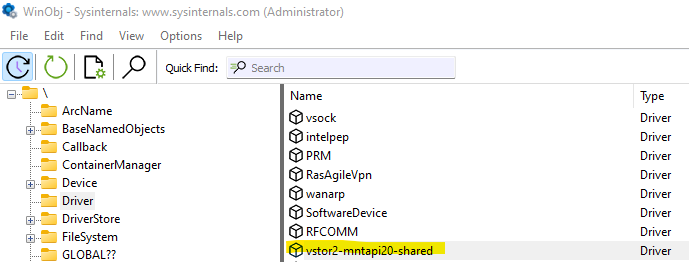
To confirm low-privileged users can interact with this driver, we take a look at the “Device” directory.
Drivers have various ways of communicating with user-land code, one common method is for the driver to expose a device that user-land code can open a handle to (using the CreateFile APIs), we find the device with the same name, double-click it and view its security attributes:
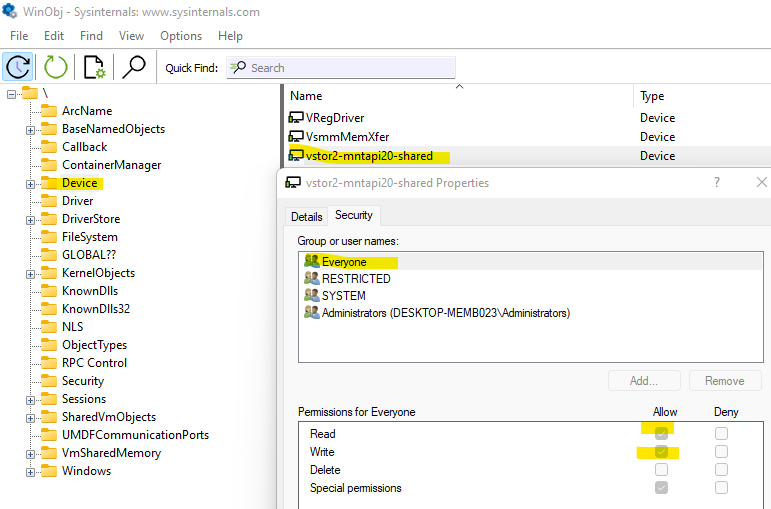
We see in the device security properties that the “everyone” group has read & write permissions, this means low-privileged users can obtain a handle to the device and use it to communicate to the driver.
Note that the driver and device names in these directories are set in the driver’s DriverEntry when it is loaded by Windows, first the device is created using IoCreateDevice, usually followed by a symbolic link creation using IoCreateSymbolicLink to give access to user-land code.

When a user-land process wants to communicate with a device driver, it will obtain a file handle to the device. In this case the code would look like:
#define USR_DEVICE_NAME L"\\\\.\\vstor2-mntapi20-shared"
HANDLE hDevice = CreateFileW(USR_DEVICE_NAME,
GENERIC_READ | GENERIC_WRITE,
FILE_SHARE_READ | FILE_SHARE_WRITE,
NULL,
OPEN_EXISTING,
0,
NULL);
This code results in the IRP_MJ_CREATE_HANDLER dispatch handler for the driver being called, this dispatch handler is part of the DRIVER_OBJECT for the target driver, which is the first argument to the driver’s DriverEntry, this structure has a MajorFunction array which can be set to function pointers that will handle callbacks for various events (like the create handler being called when a process opens a handle to the device driver).
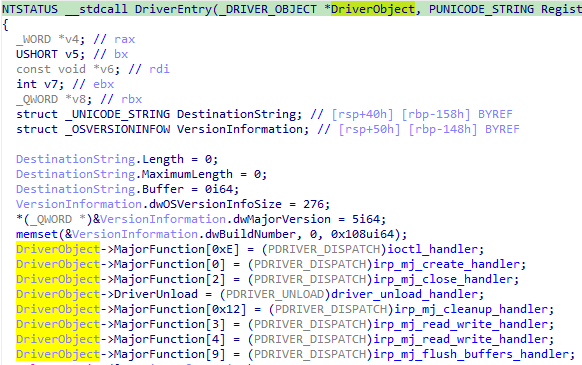
In the image above we know the first argument to DriverEntry for any driver is a pointer to the DRIVER_OBJECT structure, with this information we can follow where this variable is used to find the code that sets the function pointers for the MajorFunction array.
We can find out which MajorFunction index maps to which IRP_MJ_xxx function by looking at sample code provided by Microsoft, specifically on line 284 here.
Since we now know which array index maps to which function, we rename the functions with meaningful names as shown in the image above (e.g. we name entry 0xe to ioctl_handler, as it handles DeviceIoControl messages from processes.
The read & write callbacks are called when a process calls ReadFile or WriteFile on the device handle, there are other callbacks too which we won’t go through.
To start with, lets analyze the irp_mj_create handler and see what happens when we create a handle to this device driver.
By default, this is what we see:
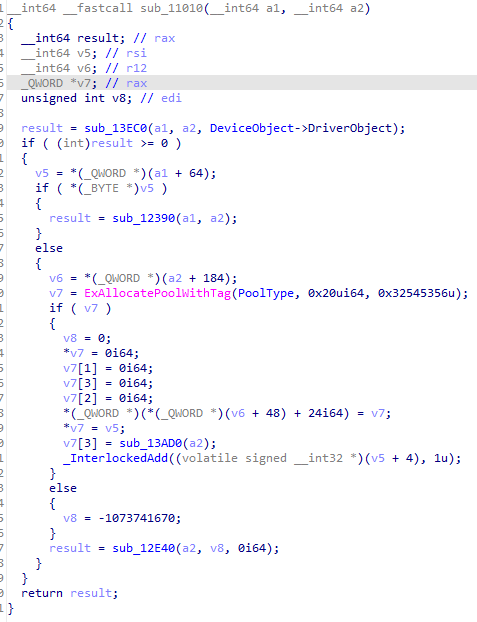
Firstly, we can improve decompilation by setting the correct types for a1 and a2, which we know must conform to the DRIVER_DISPATCH specification.
Doing so results in the following:

There’s a few things happening in this function, two important structures shown that are usually important are:
DeviceExtensionobject in theDEVICE_OBJECTstructureFsContextobject in theIRP->CurrentStackLocation->FileObjectstructure
The DeviceExtension object is a pointer to a buffer created and managed by the driver object. It is accessible to the driver via the DEVICE_OBJECT structure (and thus accessible to the driver in all DRIVER_DISPATCH callbacks. Drivers typically create and use this buffer to manage state, variables & other information the driver wants to be able to access in a variety of locations (for example, if the driver supports various functions to Open, Read, Write or Close TCP connections via IOCTLs, the driver may store its current state (e.g. whether the connection is Open or Closed) in this DeviceExtension buffer, and whenever the Close function is called, it will check the state in the DeviceExtension buffer to ensure its in a state that can be closed), essentially its just a buffer that the driver uses to store/retrieve information from a variety of contexts/functions.
The FsContext structure is similar and can be used as an arbitrary buffer, the main difference is that the DEVICE_OBJECT structure is created by the driver during the IoCreateDevice call, which means the DeviceExtension buffer does not get torn down or re-created when a user process opens or closes a handle to the device, while the FsContext structure is associated with a FILE_OBJECT structure that is created when CreateFile is called, and destroyed when the handle is closed, meaning the FsContext buffer is per-handle.
From the decompiled code we see that a buffer of 0x20 size is allocated and set to be the FsContext structure, and we also see that the first 64bits of this structure is set to v5 in the code, which corresponds to the DeviceExtension pointer, meaning we already figured out that the FsContext struct contains a pointer to the DeviceExtension as its first element.
E.g.
struct FsContext {
PVOID pDevExt;
};
Figuring out the rest of the elements to the FsContext and DeviceExtension structures is a simple but sometimes tedious process of looking at all the DRIVER_DISPATCH functions for the driver (like the ioctl handler) and noting down what offsets are accessed in these structs and how they’re used (e.g. if offset 0x8 in the DeviceExtension is used in a KeAcquireSpinLockRaiseToDpc call, then we know that offset is a pointer to a KSPIN_LOCK object).
Taking the time to documents the structures this way pays off, it helps greatly when trying to understanding the decompilation, as with some effort we can transform the IRP_MJ_CREATE handler to look like the below:
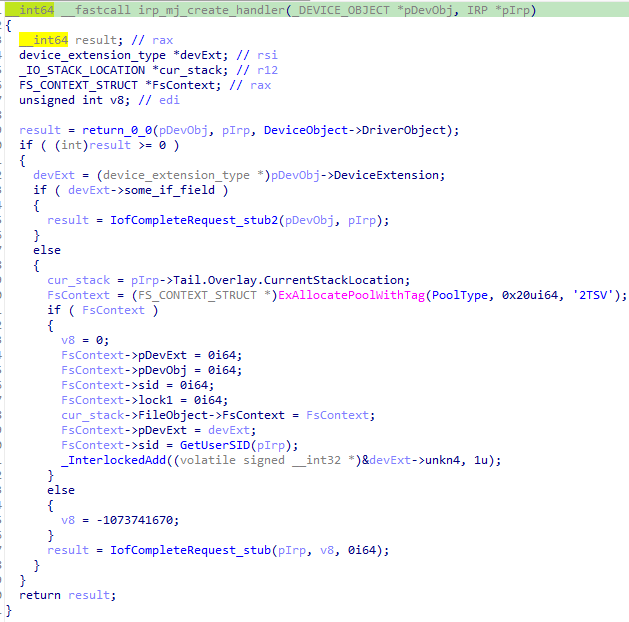
When looking at the FsContext structure for example, we can open Ida’s Local Types window and create it using C syntax, which I created below:
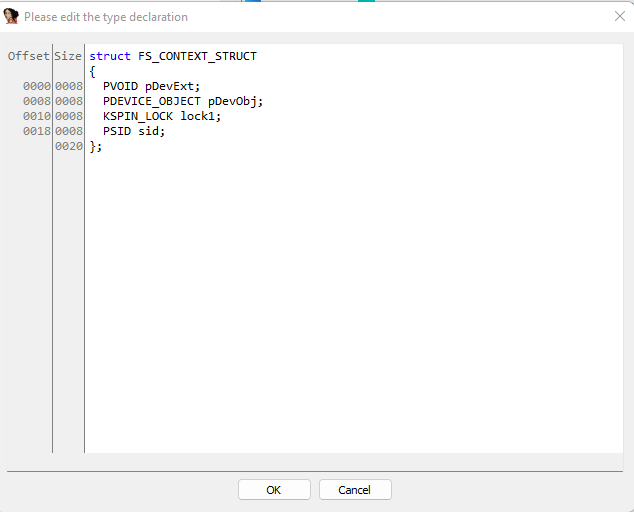
Note that as you figure out what each element is, you can define the elements as random junk and rename/retype them as you go (so long as you know the size of the structure, which we get easily here via the 0x20 size argument to ExAllocatePoolWithTag).
Now that we’ve analyzed the IRP_MJ_CREATE handler and determined there’s nothing stopping us from creating a handle, we can look into how the driver handles Read, Write & DeviceIOControl requests from user processes.
In analyzing these handlers, we see heavy usage of the FsContext and DeviceExtension buffers, including checks on whether its contents are initialized.
Turns out, there are quite a few vulnerabilities in this driver that are reachable if you form your input correctly to hit their code paths, while I won’t go through all of them (some are still pending disclosure!), we will take a look at one which is a simple user->kernel DoS.
In IOCTL 0x2A0014 we see the DeviceExtension buffer get memset to 0 to clear its contents:

This is followed by a memmove that copies 0x100 bytes from the user’s input buffer to the DeviceExtension buffer, meaning those byte offsets we copy into are user controlled (I denote this with a _uc tag at the end of the variable name:

During this IOCTL, another field in the DeviceExtension also gets set (which seems to indicate that the DeviceExtension buffer has been initialized):

This is critical to triggering the bug (which we will see next).
So, the actual bug doesn’t live in the IOCTL handlers, instead it lives in the IRP_MJ_READ and IRP_MJ_WRITE handlers (note that in this case the READ and WRITE handlers are the same function, they just check the provided IRP to determine if the operation is a READ or WRITE).
In this handler, we can see a check to determine if the DeviceExtension’s some_if_field has been initialized:

After clearing this condition, the bug can be seen in sub_12840 in the following condition statement:

Here we see I denoted the unkn13 variable in the DeviceExtension buffer with _uc, this means its user controlled (in fact, its set during the memmove call we saw earlier).
From the decompilation we see that the code does a % operation on our user controllable value, this translates to a div instruction:

If you’re familiar with X86, you’ll know that a div instruction on the value 0 causes a divide-by-zero exception, we can easily trigger this here by provided an input buffer filled with 0 when we call the IOCTL 0x2A0014 to set the user controllable contents in the DeviceExtension buffer, then we can trigger this code by attempting to read/write the device handle using ReadFile or WriteFile APIs.
In fact there are multiple ways to trigger this, as the DeviceExtension buffer is essentially a global buffer, and no locking is used when reading this value, there exist race conditions where one thread is calling IOCTL 0x2A0014 and another is calling the read or write handler, such that this div instruction may be hit right after the memset operation in IOCTL 0x2A0014 clears the DeviceExtension buffer to 0.
In fact, there are multiple locations such race conditions would affect the code paths taken in this driver!
Overall, this driver is a good target for reverse engineering practice with Kernel drivers due to its use of not only IOCTLs, but also read & write handlers + the use of the FsContext and DeviceExtension buffers that need to be reversed to understand what the driver is doing, and how we can influence it. All the bugs found in this driver were purely from static reverse engineering as a fun exercise.

